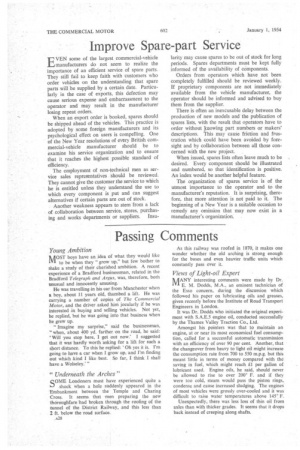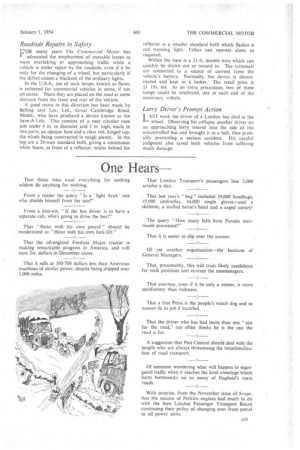Passing Comments
Page 30

Page 31

If you've noticed an error in this article please click here to report it so we can fix it.
Young Ambition
NAOST boys have an idea of what they would like Iv! to be when they "grow up," but few bother to titake a study of their cherished ambition. A recent experience of a Bradford businessman, related in the Bradford Telegraph and Argus, was, therefore, both unusual and innocently amusing.
He was travelling in his car from Manchester when a boy, about 11 years old, thumbed a lift. He was carrying a number of copies of The Commercial Motor, and the driver asked him jocularly if he was interested in buying and selling vehicles. Not yet, he replied, but he was going into that business when he grew up.
"Imagine my surprise," said the businessman, "when, about 400 yd. farther on the road, he said: 'Will you stop here, I get out now.' I suggested that it was hardly worth asking for a lift for such a short distance. To this he replied: 'Oh yes it is. I'm going to have a car when I grow up, and I'm finding out which kind I like best. So far, I think I shall have a Wolseley.' "
Underneath the Arches"
COME Londoners must have experienced quite a shock when a hole suddenly appeared in the Embankment between the Temple and Charing Cross. It seems that men preparing the new thoroughfare had broken through the roofing of the tunnel of the District Railway, and this less than 2 ft. below the road surface. As this railway was roofed in 1870, it makes one wonder whether the old arching is strong enough for the buses and even heavier traffic units which constantly pass over it.
Views of Light-oil Expert
IMANY interesting comments were made by Dr. I" E. M. Dodds, M.A., an eminent technician of the Esso concern, during the discussion which followed his paper on lubricating oils and greases, given recently before the Institute of Road Transport Engineers in London.
It was Dr. Dodds who initiated the original experiment with S.A.E.S engine oil, conducted successfully by the Thames Valley Traction Co., Ltd.
Amongst his pointers was that to maintain an engine, at or near its most economical fuel consumption, called for a successful automatic transmission with an efficiency of over 90 per cent. Another, that the changeover from heavy to light oil might increase the consumption rate from 700 to 550 m.p.g. but this meant little in terms of money compared with the saving in fuel, which might reach £1 per gallon of lubricant used. Engine oils, he said, should never be allowed to rise to over 200° F. and if they were too cold, steam would pass the piston rings, condense and cause increased sludging. The engines of most vehicles were grossly over-cooled and it was difficult to raise water temperatures above 145° F.
Unexpectedly, there was less loss of thin oil from axles than with thicker grades. It seems that it drops back instead of creeping along shafts.
Roadside Repairs in Safety
FOR many years The Commercial Motor has I advocated the employment of movable lamps to warn overtaking or approaching traffic while a vehicle is under repair by the roadside, even if it be only for the changing of a wheel, but particularly if the defect causes a blackout of the ordinary lights.
In the U.S.A., use of such lamps, known as flares, is enforced for commercial vehicles in some, if not all states. There they are placed on the road at some distance from the front and rear of the vehicle.
A good move in this direction has been made by Belling and Lee, Ltd„ Great Cambridge Road, Middx., who have produced a device known as the Save-A-Life. This consists of a neat circular case" just under 4 in. in diameter and 3 in. high, made in two parts, an opaque base and a clear red, hinged top, the whole being constructed in tough plastic. In the top are a 24-watt standard bulb, giving a continuous white beam, in front of a reflector, whilst behind the reflector is a smaller standard bulb which flashes a red warning light. Either can operate alone as required.
Within the base is a 2I-ft. double wire which can quickly be drawn out or 'wound in. The terminals are connected to a source of current from the vehicle's battery. Normally, the device is disconnected and kept in a locker. The retail price is LI 19s. 6d. As an extra precaution, two of these lamps could be employed, one at each end of the stationary vehicle.
Lorry Driver's Prompt Action
LAST week the driver of a London bus died at the wheel. Observing his collapse another driver on an approaching lorry steered into the side of the uncontrolled bus and brought it to a halt, thus probably preventing a serious accident. His careful judgment also saved both vehicles from suffering much damage.




























































































